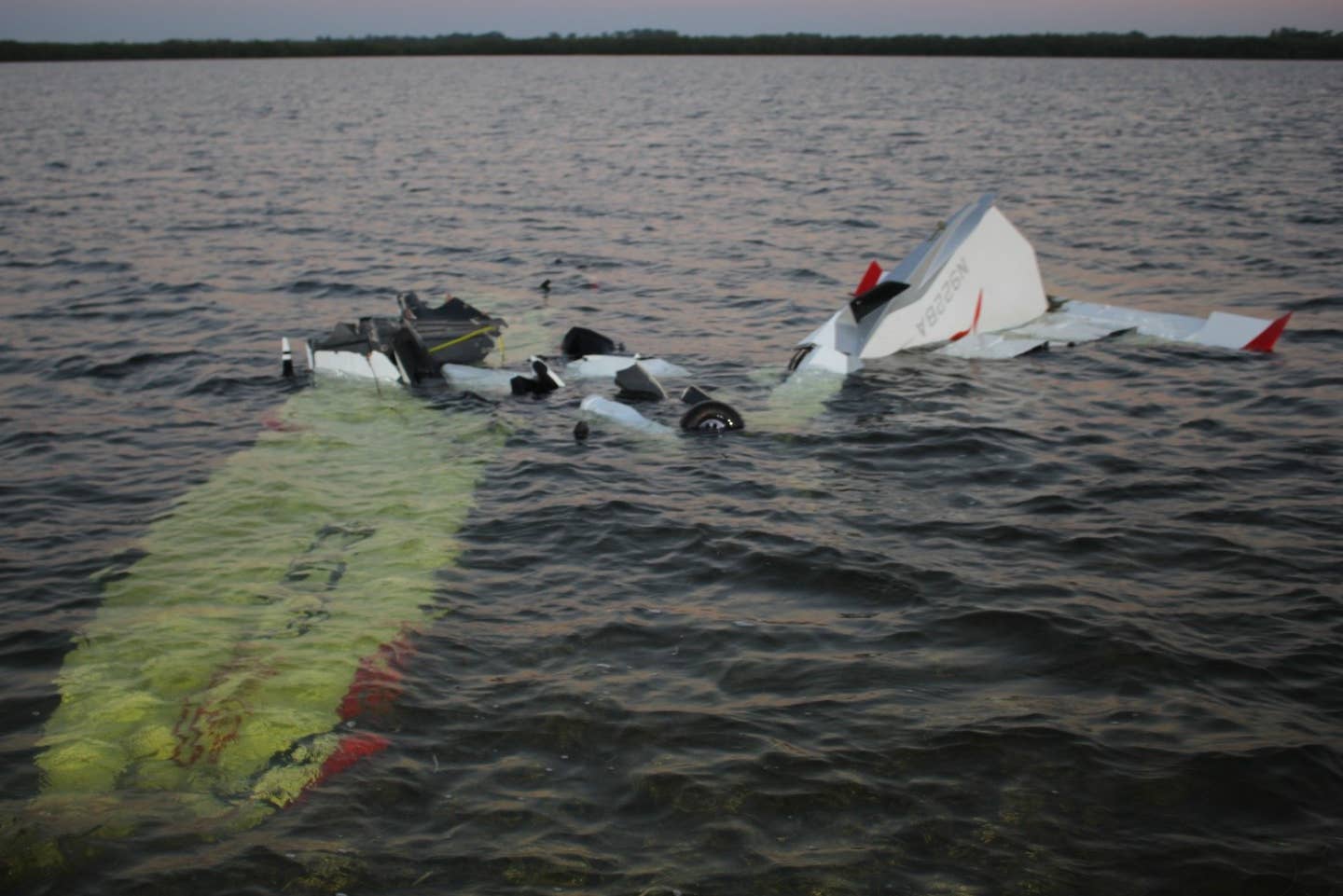
Halladay’s aircraft hit the water at a 45-degree nose-down attitude. NTSB Report
Some element of human interaction, or lack of one, is responsible for nearly 70 percent of all aircraft accidents. Most of those involve violating a least one FAR, like flying a VFR aircraft into IFR weather, busting minimums on an approach, or a pilot flying when common sense said they weren't in physical shape to act as pilot in command.
The NTSB's recent report of the known facts surrounding the November 7, 2017, Icon A5 accident near Clearwater, Florida, that claimed the life of baseball Hall of Fame star Roy Halladay was nothing short of eye opening. While looking deeply into the pathological data uncovered might seem somewhat macabre, the lessons to be learned make it worth the effort. Halladay's autopsy, part of the larger NTSB report, discovered his blood stream was riddled with medications, any one of which would have been enough to disqualify him from flying. At the time of the accident, Halladay held a private pilot certificate with both single- and multi-engine ratings, as well as a Class 1 FAA medical certificate. He'd logged 721 total flying hours, including 51.8 in the A5.
The report also detailed some of the aerial maneuvers Halladay was performing close to shore before the accident, information captured by a tiny digital data recorder installed on the A5, as well as from people near the water. Some of the steep turns exceeded 45 degrees of bank, while eye witnesses said the airplane's altitude varied from on the deck up to 300 feet and back, numbers confirmed by the Icon's data unit. Once Halladay lost control of the A5, the airplane impacted the water at a 45-degree nose-down attitude, coming to rest inverted in four feet of water.
NTSB investigators discovered the baseball player had a history of substance abuse significant enough to require inpatient rehabilitation twice between 2013 and early 2015, with diagnoses of chronic back pain, insomnia, and depression—issues that were treated with various prescription medications. The pilot's personal medical records for 2016 and 2017 were not available. The pilot's possession of a current Class 1 medical seems at best contradictory with the illegal substances in his bloodstream.
FAR 91.17 says pilots shouldn’t drink anything alcoholic within eight hours of flying, but leaves the topic of which medications are OK to the FAA’s flight surgeons, essentially everything except an aspirin. Impairing medications found in Halladay’s bloodstream included Zolpidem (sleeping aid), Amphetamine, Morphine (pain killer), Fluoxetine (anti-depressant), Baclofen (muscle relaxer) and Hydromorphone (pain killer). Specifically, the NTSB said the amount of Amphetamine found in Halladay’s blood was nearly 10 times greater than what would be expected from a person using the medication in a prescribed manner, such as for treating attention deficit disorder.
The pilot's judgment was certainly in question when Halladay flew his Icon much closer to shore than the 500 feet required by Part 91.119, as well as the maneuvers he performed in which the aircraft's angle of attack and load factor continually increased until the moment of impact. The Icon is equipped with an angle of attack indicator that offers a clear indication of how hard the aircraft's wing is working, as well as how close the airfoil might be to exceeding the critical AoA needed to keep the aircraft airborne. An aerodynamic stall begins at 15.6 degrees on the Icon's AoA.
The board said, "The pilot initiated a final maneuver: a climbing right turn from a GPS altitude of 210 ft and an indicated airspeed of 81 knots. The airplane's load factor increased rapidly to 1.91 Gs and then varied between 1 and about 2 Gs as the AoA increased steadily to 15 degress, which is at the top of yellow band on the AoA indicator." During the same maneuver, the bank angle of the A5 increased to more than 50 degrees. Halladay lost control of the aircraft shortly after this maneuver.
The Icon A5 includes an emergency ballistic parachute as standard equipment. Halladay never used the chute on the A5, perhaps because the before-takeoff checklist includes a note to remove the system's safety pin so it would be instantly available if needed. Investigators found that the safety pin on Halladay's airplane Icon had never been removed prior to the accident flight.
Following another fatal A5 accident earlier in 2017, the company on October 23, 2017, issued a bulletin called "Low Altitude Flying Guidelines" that was distributed to A5 clients and owners. "According to the chief executive officer of the company at that time," the report said, "the document was created to emphasize some of the known hazards of flying light sport aircraft and to provide mitigating solutions, even though that information was already available in company training and operating manuals. The company official stated that he 'was certain' the accident pilot received and reviewed the guidelines."
There were other elements in Halladay's flying history that were also indicative of his state of mind at least—though the state of his health at the time is unknown—including one he mentioned in his logbook. While en route from the Peter O. Knight Airport in Tampa, Florida, to his home just a week prior to the accident, Halladay flew beneath the Sunshine Skyway Bridge with a 180-ft vertical clearance above the water. A few days later, he said on social media that "flying the Icon A5 over the water is like flying a fighter jet" Halladay seems to have been oblivious to the FAA's catch-all regulation 91.13 that says, "No person may operate an aircraft in a careless or reckless manner so as to endanger the life or property of another."
While the NTSB has not yet officially determined the probable cause of Halladay’s accident, one final note in the Low Altitude Flying bulletin also seems to have been ignored. It warns pilots, “Do not show off.”

Sign-up for newsletters & special offers!
Get the latest FLYING stories & special offers delivered directly to your inbox






